This video says that all my theory about directivity, of a woofer, based on diameter, is a lie 🙁🙁🙁
In other news, I am comparing and contrasting the jbl 4” aquaplas and the axi2050
With the axi2050 I can cross lower, maybe as low as 200hz, keeping the vocal range intact, instead of dividing it with a crossover.
The jbl subjectively has more resolution in the top end, crossed at ~500hz leaving the “critical band” (700hz-7000hz) intact but dividing the midrange, leaving the lower half to the Td15m.
Since 15m is of large diameter, would not the mid range also have some of the dynamic contrast known to that of cd+horn nature?
I wonder could one really run the axi down to 200hz? Would a jmlc 200 be suffice?
If I get the axi would it be best to cross to the Td15m or eliminate it, and cross straight to the 18h+?!?
With the axi2050 I can cross lower, maybe as low as 200hz, keeping the vocal range intact, instead of dividing it with a crossover.
The jbl subjectively has more resolution in the top end, crossed at ~500hz leaving the “critical band” (700hz-7000hz) intact but dividing the midrange, leaving the lower half to the Td15m.
Since 15m is of large diameter, would not the mid range also have some of the dynamic contrast known to that of cd+horn nature?
I wonder could one really run the axi down to 200hz? Would a jmlc 200 be suffice?
If I get the axi would it be best to cross to the Td15m or eliminate it, and cross straight to the 18h+?!?
I remember reading someplace the xover of jlmc should be at least an octave above horn cutoff but my memory is not so great.
Potential Excellence
1) The Celestion axi2050 is a highly refined design of a large format compression driver similar to the Community M4 with a far superior performance.
2) With a large annular diaphragm and accompanying dual surround, rocking modes that occur at lower frequencies are suppressed while relative large excursion remain materially linear, and while a respectable volume displacement is delivered.
3) The waffleized diaphragm mitigates breakup modes at high frequencies as well.
4) The phase plug is designed to deliver a planer wave front at driver exit, which provides an ideal match with an O.S. Horn throat and body (joined at its hyperbolic apex).
5) The PWT frequency response curve is impressive. It is essentially ruler flat over the range 100-3,000 Hz. with gradual downward slopes beyond. Amazing!
The challenge here will be, designing a horn that does not impair such a superlative performance, while maintaining a reasonable directivity constant.
WHG
You will be hard pressed to find a competitive driver of equivalent performance if the disclosures made by Celestion are accurate. Some reasons for this observation follow:In other news, I am comparing and contrasting the jbl 4” aquaplas and the axi2050 <snip>
1) The Celestion axi2050 is a highly refined design of a large format compression driver similar to the Community M4 with a far superior performance.
2) With a large annular diaphragm and accompanying dual surround, rocking modes that occur at lower frequencies are suppressed while relative large excursion remain materially linear, and while a respectable volume displacement is delivered.
3) The waffleized diaphragm mitigates breakup modes at high frequencies as well.
4) The phase plug is designed to deliver a planer wave front at driver exit, which provides an ideal match with an O.S. Horn throat and body (joined at its hyperbolic apex).
5) The PWT frequency response curve is impressive. It is essentially ruler flat over the range 100-3,000 Hz. with gradual downward slopes beyond. Amazing!
The challenge here will be, designing a horn that does not impair such a superlative performance, while maintaining a reasonable directivity constant.
WHG
Last edited:
You're going to need a huge horn to cross at 200hz.. ideally with horn loading to 100hz
Stick to constant directivity, something like a double sized K402; that jmlc 200 narrows in directivity a lot
Stick to constant directivity, something like a double sized K402; that jmlc 200 narrows in directivity a lot
If I get the axi would it be best to cross to the Td15m or eliminate it, and cross straight to the 18h+?!?
This is an option to consider.
The TD18H+ would only have to cover 3 octaves (30-240Hz).
Is the rule of thumb 4-5 or less octaves per driver? Maybe the less octaves a driver has to carry the better? At least the xovers are out of the mid range. Would it be weird to have one 15 run 240-70hz, and the 18 run 70hz-below?
Jean Michel on LeCleac'h horns
I think it is accepted that a 200hz tractrix can play down to 300hz anyway.
Interesting quote from one of my fav threadssome time ago i made a tractrix horn with 25" ( 60cm ) mouth diameter, ( see picture below ) and tested it with the Radian 950Pb, crossing quit low, at 300hz/12db. Performance was tremendous, despite many say, to use a horn driver below Fs increases distortion dramatically. I didn't hear this.
Jean Michel on LeCleac'h horns
I think it is accepted that a 200hz tractrix can play down to 300hz anyway.
No, it's not weird to use 2 drivers between 30-240Hz, even less if horns are used for this range.
Considering direct radiating cones in a non pro environment, the 18" would suffice.
A 200Hz Tractrix will probably play down to 300Hz, but I would prefer not to use it below 400Hz.
Considering direct radiating cones in a non pro environment, the 18" would suffice.
A 200Hz Tractrix will probably play down to 300Hz, but I would prefer not to use it below 400Hz.
Hello Camplo, Just FYI CONSTRUCTION DU PAVILLON 60*60 was my first (and old) website (Collignon is my name...) Have made lots of horns, the bigger ones (120Hz JMLC) was at the beginning of the Marc Henry idea of making the project called "la grande castine" . You can see a prototype of it with JMLC & Jean Hiraga surprised : Post | Latelierdumicrophone. At the Triode Festival, Tim de Paravicini, a great designer of hi-fi and studio electronics, has been listening to almost all of Little Richard's usual test CD ("the drum is real, the piano is real, everything is real!") And the entire evening that has followed, until 2am, the room was full, and the guys were applauding between the pieces! It's the only time Marc Henry have seen that. So I think that big Horns have something that impress people...And no need to cut it at 2 times the cut off frequency.Interesting quote from one of my fav threads Jean Michel on LeCleac'h horns I think it is accepted that a 200hz tractrix can play down to 300hz anyway.
I forget this link http://forums.melaudia.net/attachment.php?aid=1760
Very interesting isn't it?
Hello Camplo.....And no need to cut it at 2 times the cut off frequency.
Are you suggesting that the cut off is the actual limit for all thing hifi? Is my 116db at 1 meter still within "home use"....So my jmlc 350Hz could be used doen to ....350hz....and if the 950pb played 250hz I wonder if I can use my jbl at 350.....if not how is that you determine the "limits"?
Also do you have a guide on how you made your horns? I have a couple but the more I can see,the better for me, I'm still trying to figure out how they are made out of concrete as well...
best regards
Camplo
vc08, thank you for posting.
camplo, here are some pictures of Marco Henry's construction method.
He applies gypsum to a mold for the Grande Castine horns, but has also used other materials.
camplo, here are some pictures of Marco Henry's construction method.
He applies gypsum to a mold for the Grande Castine horns, but has also used other materials.
Attachments
-
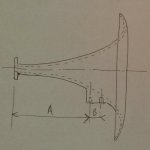 14915697_1130910923631528_5427612997356348990_n.jpg20.7 KB · Views: 497
14915697_1130910923631528_5427612997356348990_n.jpg20.7 KB · Views: 497 -
 15267711_1161607863895167_145137941286006530_n.jpg26.4 KB · Views: 497
15267711_1161607863895167_145137941286006530_n.jpg26.4 KB · Views: 497 -
 16992161_1248244591898160_5191287879969922740_o.jpg140.5 KB · Views: 514
16992161_1248244591898160_5191287879969922740_o.jpg140.5 KB · Views: 514 -
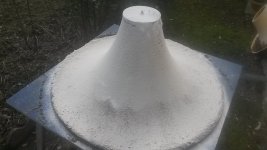 16992098_1248244578564828_9116325555712766049_o.jpg131.3 KB · Views: 504
16992098_1248244578564828_9116325555712766049_o.jpg131.3 KB · Views: 504 -
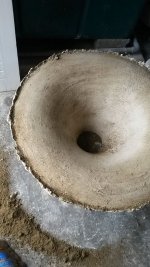 16992339_1248244658564820_7638552043206090412_o.jpg155.7 KB · Views: 509
16992339_1248244658564820_7638552043206090412_o.jpg155.7 KB · Views: 509 -
 14955828_1140756329313654_7428705617730072649_n.jpg51.1 KB · Views: 127
14955828_1140756329313654_7428705617730072649_n.jpg51.1 KB · Views: 127
Last edited:
Some more:
Attachments
-
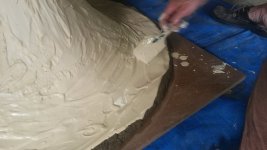 19222963_1351042808285004_8066937569738425032_o.jpg180.5 KB · Views: 135
19222963_1351042808285004_8066937569738425032_o.jpg180.5 KB · Views: 135 -
 19400353_1351042824951669_1681113721016541113_o.jpg231.4 KB · Views: 131
19400353_1351042824951669_1681113721016541113_o.jpg231.4 KB · Views: 131 -
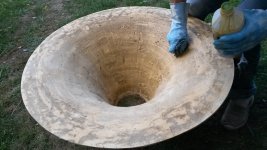 19238260_1346482372074381_5851917619037819223_o.jpg377.8 KB · Views: 155
19238260_1346482372074381_5851917619037819223_o.jpg377.8 KB · Views: 155 -
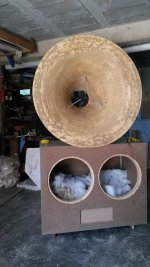 19388438_1348431258546159_3912258663535895520_o.jpg229.7 KB · Views: 162
19388438_1348431258546159_3912258663535895520_o.jpg229.7 KB · Views: 162 -
 19400662_1351042714951680_8708609255251623676_o.jpg151.6 KB · Views: 150
19400662_1351042714951680_8708609255251623676_o.jpg151.6 KB · Views: 150 -
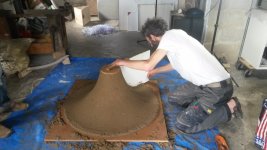 19388658_1351042711618347_3240488082384531198_o.jpg211 KB · Views: 157
19388658_1351042711618347_3240488082384531198_o.jpg211 KB · Views: 157 -
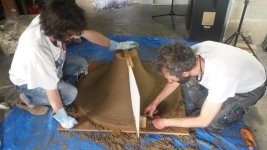 19250547_1351042718285013_7510629842257347137_o.jpg216 KB · Views: 157
19250547_1351042718285013_7510629842257347137_o.jpg216 KB · Views: 157 -
 19092926_1344795832243035_5743643657770447575_o.jpg203.6 KB · Views: 139
19092926_1344795832243035_5743643657770447575_o.jpg203.6 KB · Views: 139 -
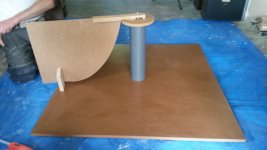 19055083_1344795818909703_7290175461722538486_o.jpg153.9 KB · Views: 141
19055083_1344795818909703_7290175461722538486_o.jpg153.9 KB · Views: 141 -
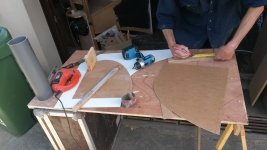 19143144_1344795825576369_5561775440551773793_o.jpg206 KB · Views: 128
19143144_1344795825576369_5561775440551773793_o.jpg206 KB · Views: 128
Jean-Michel Le Cléac'h on cut-off:
"A perfect horn should provide a resistive acoustic impedance and no reactance to the loudspeaker .
Impedance of real horns allways possess a reactive part. At high frequency all horns and waveguide possess a nearly pure resistive impedance. Things differs when frequency decreases.
For horns belonging to the hyperbolic family (from catenoidal to exponential), there is a more or less large peak of reactive impedance around the cut-off frequency (that can be eventually defined as the frequency for which the resistive part is the half value of the acoustic resistance at high frequency).
As an example of acoutical impedance you can see David McBean comparison between measured (circle) and calculated (line) resistive part and reactive part.

This reactive part of the acoutical impedance is responsible of a variation of phase and a subsequent rise in group delay. Near the cut off the group delay rise a lot and for a medium horn it can be larger than 1 meter (I prefer to express the delay in equivalent distance travelled at the speed of sound). For my own use I only use the horn upon a frequency for which the group delay is lesser than 10 centimeters. If you use a high pass crossover frequency too much near of the cut-off of the horn then the results is that if you have a musical note having a fundamental near that frequency, it will be delayed (more than 1 meter sometimes) from the harmonics. With a violin or whatever instruments it means that there will be some stretching of the shape of the instruments...
But there is also another situation related to phase distortion (or more precisely pulse distortion) it is the reflection of waves from every element creating diffraction inside the horn or more often at mouth. This is responsible of a reflection of a part of the energy of the direct wave in direction of the loudspeaker and a subsequent interference between the reflected wave and the direct wave. The pulse response is distorted and even you may see small delayed pulses on the pulse response measurement.
The Le Cléac'h horn, with its continuous profile and its curved mouth is nearly free of this pulse distortion as you may see on the the pulse reponse,response curve and waterfall of a Le Cléac'h horn (red is for current drive, blue for voltage drive)."

"A perfect horn should provide a resistive acoustic impedance and no reactance to the loudspeaker .
Impedance of real horns allways possess a reactive part. At high frequency all horns and waveguide possess a nearly pure resistive impedance. Things differs when frequency decreases.
For horns belonging to the hyperbolic family (from catenoidal to exponential), there is a more or less large peak of reactive impedance around the cut-off frequency (that can be eventually defined as the frequency for which the resistive part is the half value of the acoustic resistance at high frequency).
As an example of acoutical impedance you can see David McBean comparison between measured (circle) and calculated (line) resistive part and reactive part.
This reactive part of the acoutical impedance is responsible of a variation of phase and a subsequent rise in group delay. Near the cut off the group delay rise a lot and for a medium horn it can be larger than 1 meter (I prefer to express the delay in equivalent distance travelled at the speed of sound). For my own use I only use the horn upon a frequency for which the group delay is lesser than 10 centimeters. If you use a high pass crossover frequency too much near of the cut-off of the horn then the results is that if you have a musical note having a fundamental near that frequency, it will be delayed (more than 1 meter sometimes) from the harmonics. With a violin or whatever instruments it means that there will be some stretching of the shape of the instruments...
But there is also another situation related to phase distortion (or more precisely pulse distortion) it is the reflection of waves from every element creating diffraction inside the horn or more often at mouth. This is responsible of a reflection of a part of the energy of the direct wave in direction of the loudspeaker and a subsequent interference between the reflected wave and the direct wave. The pulse response is distorted and even you may see small delayed pulses on the pulse response measurement.
The Le Cléac'h horn, with its continuous profile and its curved mouth is nearly free of this pulse distortion as you may see on the the pulse reponse,response curve and waterfall of a Le Cléac'h horn (red is for current drive, blue for voltage drive)."
Last edited:
I finally was able to read this post a little more thoroughly and....yes, good catch Ro808, group delay never crossed my mind as far as horn characteristics go.
maybe it has something to do with this..............
Hmm, a quick check on horn depth………………………
A late friend of mine (djk) said……………..
“ "Quarter Wave/Beranek texts"
The horn needs to be 1/2W for smooth treble, not 1/4W.
Most important graphs (Olson). 5.10 shows mouth size, 5.11 shows depth.”
Then another member texted me…………
“I have been crossing over to the PT 1010HF-1 at 2K and above because there is typically a huge ragged acoustic impedance peak right about 1.6KHz. The depth of the waveguide is right at ¼ wavelength at 1.6K. About 4.3 inches. That makes for one huge reflection or family of HOM’s, if you are a believer, centered around 1.6KHz.”
The freq response can be seen in a rippling in freq response below 2khz using the same horn with a 2435hpl.
see post 1
Advice needed for PTH1010 2435HPL Combo
can we see this on a waterfall response ?
or is it just a resistive thing, not a resonance...............
Hmm, a quick check on horn depth………………………
A late friend of mine (djk) said……………..
“ "Quarter Wave/Beranek texts"
The horn needs to be 1/2W for smooth treble, not 1/4W.
Most important graphs (Olson). 5.10 shows mouth size, 5.11 shows depth.”
Then another member texted me…………
“I have been crossing over to the PT 1010HF-1 at 2K and above because there is typically a huge ragged acoustic impedance peak right about 1.6KHz. The depth of the waveguide is right at ¼ wavelength at 1.6K. About 4.3 inches. That makes for one huge reflection or family of HOM’s, if you are a believer, centered around 1.6KHz.”
The freq response can be seen in a rippling in freq response below 2khz using the same horn with a 2435hpl.
see post 1
Advice needed for PTH1010 2435HPL Combo
can we see this on a waterfall response ?
or is it just a resistive thing, not a resonance...............
Attached is an article that should not be omitted in this thread.
"Improved Loudspeaker System for Theaters", dated November, 1945 and written by J. B. Lansing and J. K. Hilliard.
The article briefly describes the objectives in developing the Altec A-2 (GM's avatar) and A-4 two way loudspeaker systems, as well as the legendary 288 compression driver and 515 woofer.
It makes one wonder to what extent any substantial progress has been made in the last 70 years.
These Altec loudspeaker systems and drivers are the immediate successors of the pre-war WE products.
After reading, I felt the desire to listen to those systems.
"Improved Loudspeaker System for Theaters", dated November, 1945 and written by J. B. Lansing and J. K. Hilliard.
The article briefly describes the objectives in developing the Altec A-2 (GM's avatar) and A-4 two way loudspeaker systems, as well as the legendary 288 compression driver and 515 woofer.
It makes one wonder to what extent any substantial progress has been made in the last 70 years.
These Altec loudspeaker systems and drivers are the immediate successors of the pre-war WE products.
After reading, I felt the desire to listen to those systems.
Attachments
Last edited:
- Home
- Loudspeakers
- Multi-Way
- Is it possible to cover the whole spectrum, high SPL, low distortion with a 2-way?